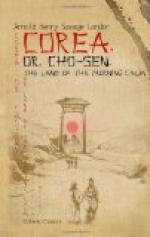[Illustration: CAVALRY SOLDIER WITH UMBRELLA-HAT]
Cavalry soldiers were to be seen in their picturesque blue and brown costumes, and cuirasses, and wide-awake black hats adorned with long red tassels hanging down to the shoulders, or, as an alternative, equipped with iron helmets and armed with flint-locks and spears. In their belts, on one side, they carried swords, and on the other, oil-paper umbrella-shaped covers. When folded, one of these hat-covers resembles a fan; and when spread out for use, it is fastened over the hat by means of a string. Those warriors who wore helmets carried the round felt hats as well, fastened to the butts of their saddles.
This cavalry equipment was in great contrast, from a picturesque point of view, with the comical imitations of the European mode of equipment exhibited by the infantry soldiers. One peculiarity of these cavalrymen was their instability in the saddle. Each cavalier had a mapu to guide the horse, and another man by his side to see that he did not fall off, each having thus two men to look after him. A charge of such cavalry on the battle-field must, indeed, be a curious sight.
In the olden time it was forbidden for any one to look down on the king from any window higher than the palanquins, but now the rule is not so strictly observed, although, even at the time when I witnessed these processions, nearly all the higher windows were kept closed and sealed by the more loyal people. The majority, therefore, witnessed the scene from the streets.
The procession was headed by several hundred infantry soldiers, marching without the least semblance of order, and followed by cuirassed cavalrymen mounted on microscopic ponies in the manner above described. Then followed two rows of men in white, wearing square gauze white caps, similar to those which form the distinctive badge of the students when they go to their examinations; between which two rows of retainers, lower court officials, and yamens, perched on high white saddles, rode the generals and high Ministers of state, supported by their innumerable servants. Narrow long white banners were carried by these attendants, and a dragon-flag of large dimensions towered above them. Amid an almost sepulchral silence, the procession moved past, and after it came a huge white palanquin, propped on two long heavy beams, and carried on the shoulders of hundreds of men.




